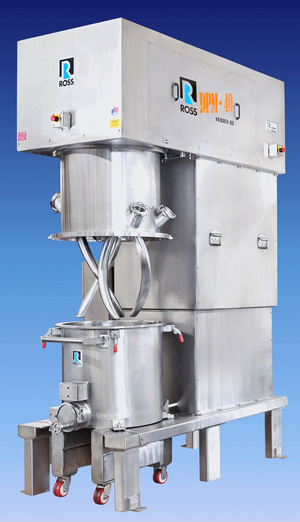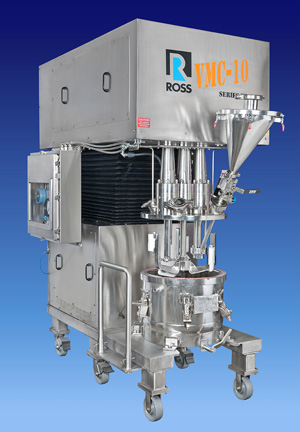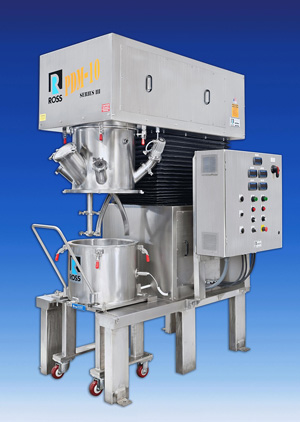The Expert's Corner
Ask an Expert: Mixers for Producing Capsule Shells
April 12, 2021
Capsule shell chemistries today must meet a myriad of requirements, including those affected by consumer preferences, the need for compatibility with active pharmaceutical ingredients, a formulation`s dissolution rates and moisture sensitivity, the acceptable oxygen permeability, and the overall product stability.
The most common are hard gelatin capsules, typically made of collagen material of animal origin. Vegetarian options include capsules made of hydroxypropyl methylcellulose (HPMC), potato starch, and pullulan (tapioca). Secondary gelling agents, such as carrageenan, gellan gum, pectin, agar, and xanthan gum, may also be present. Capsule suppliers also make capsules from polyvinyl acetate (PVAc) for filling with water-insoluble drugs that have been dissolved in solvents such as polyethylene glycol (PEG).
Capsule shells are classified as hard or softgel, with the latter being plasticized by the addition of glycerin, sorbitol, or a similar polyol. Pharmaceutical manufacturers may fill capsules with powders, granules, pellets, liquids, gels, pastes, or smaller capsules. With the right chemical and physical properties, shells can accommodate a combination of incompatible ingredients in a single capsule.
Given the different raw materials and application requirements at play, you can simplify mixer selection for a particular capsule-shell formulation by considering the formulation`s viscosity and the appropriate level of shear. The viscosity profile during mixing is a function of the formulation itself, but other factors also influence it, such as the order of adding ingredients, the processing temperature, and the shear input. For the most part, the affinity of the dry components to the liquid vehicle—how easily the powders disperse or dissolve—dictates the suitable mixing action and intensity.

Double planetary mixer
If the batch is considerably thick, dense, and/or sticky, a double planetary mixer (DPM) is typically the best choice (photo). Its relatively low speed relies on a formulation`s high viscosity to impart shear as its two identical blades turn on individual axes while circling the batch, pushing material against the vessel`s surfaces and between the blades. The higher the viscosity, the greater the shear resulting from the kneading action of the DPM blades, which helps to smooth the consistency and break apart loose agglomerates.
Certain capsule gels are shear-sensitive and a perfect fit for the low-speed DPM blades, regardless of whether the viscosity stays relatively fluid. For dry ingredients that are fairly easy to disperse, with lumps readily disintegrating under low shear, the DPM`s gentle yet thorough mixing action is ideal. As an added advantage, you can easily deaerate a batch by pulling vacuum in the DPM. In contrast, a high-speed blade can sometimes micronize entrained air in the material, making it hard to remove even under a deep vacuum, and you potentially can over-shear the product, which could lead to a permanent viscosity loss.
Multi-shaft mixer
A multi-shaft mixer is effective for capsule formulations that require high shear but aren`t extremely viscous. Slick or slippery gels are often good candidates for processing in a multi-shaft mixer, which comprises two or more independently driven agitators working in tandem. A low-speed anchor can complement one or two high-shear devices, such as an open, disc-style disperser blade or a rotor/stator assembly.

On its own, a disperser blade can produce acceptable flow patterns in batches up to around 50,000 centipoises and the rotor/stator assembly up to around 10,000 centipoises. For applications exceeding those ballpark viscosity limits, an anchor agitator is necessary to ensure sufficient bulk flow and to deliver the formulation to the high-shear device. The anchor is often fitted with scrapers to wipe formulation from a vessel`s surfaces and optimize heat transfer. A vessel`s sidewalls and bottom are typically jacketed for heating and cooling purposes.
For added efficiency, you can replace the conventional rotor/stator in a multi-shaft mixer with a modified assembly designed for subsurface powder induction (photo). Such systems offer a seamless way to introduce solids directly into the high-shear zone for immediate dispersion. This technique shortens the mixing process by preventing powders from floating on the batch surface or forming persistent lumps, called fish eyes. It also minimizes dusting, a common processing issue associated with lightweight powders.
Such a method of solids induction is most applicable when the liquid vehicle is starting at a water-like or very low viscosity. The modified assembly designed for subsurface powder induction in a multi-shaft mixer doesn`t rely on an external vacuum pump but does require high liquid flow to generate a powerful suction for powder injection. One possible variation in this type of system is a standalone, high-shear mixer for processing low-viscosity formulations and intermediates.

Hybrid planetary mixer
If high viscosity and high shear requirements both apply, the best solution is typically a hybrid planetary mixer (photo), which combines the thorough mixing action of a planetary stirrer with the added benefit of a high-speed disperser. Both the planetary blade and the high-speed disperser rotate on their own axes while revolving around a central axis. The orbiting planetary blade continuously sweeps the vessel`s surfaces and carries material toward the disperser. This helps to distribute heat resulting from the fast-spinning sawtooth blade, keeping both temperature and viscosity uniform throughout the batch at all times. Variable speed allows precise control of shear rates to minimize the degradation of any shear-sensitive components.
Featured article in Tablets & Capsules